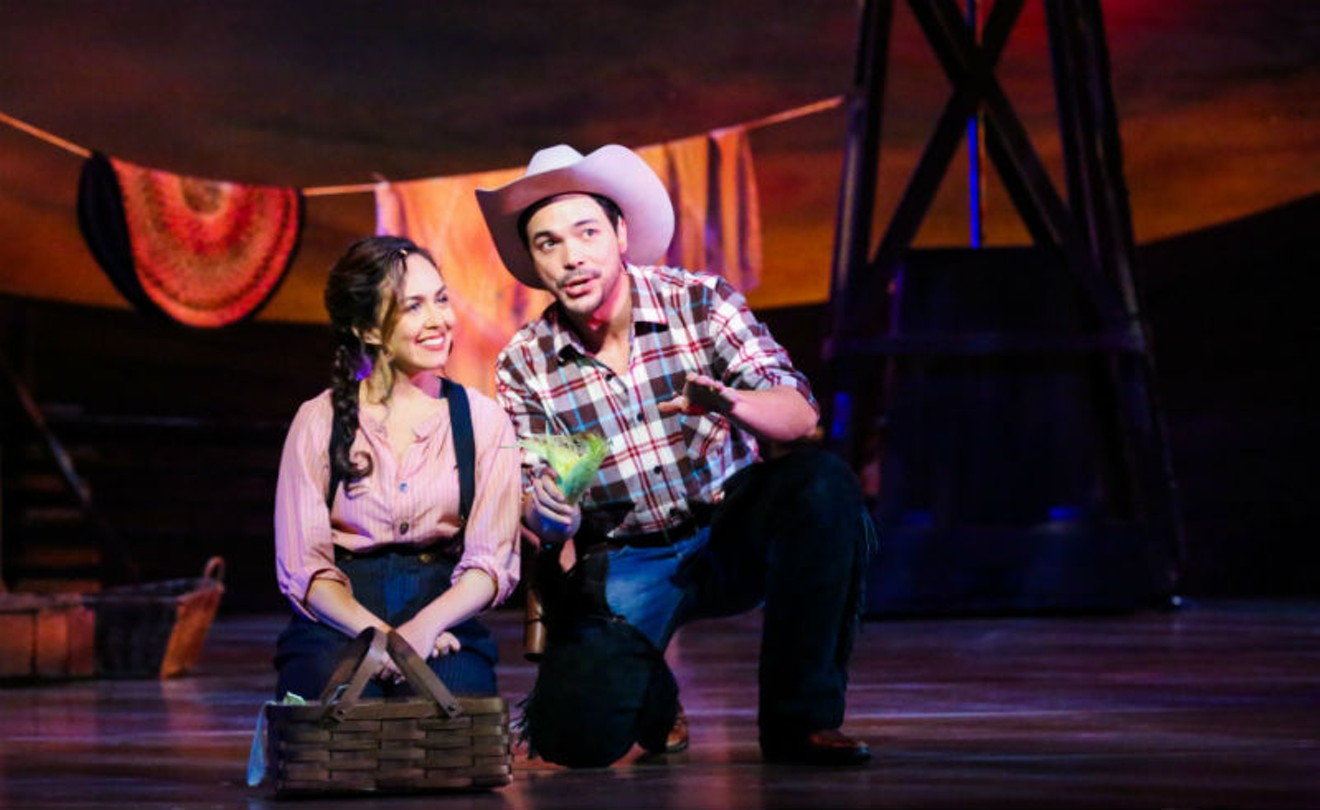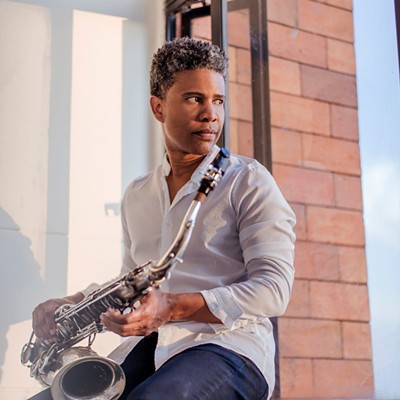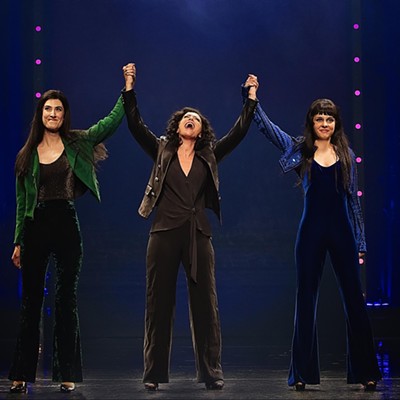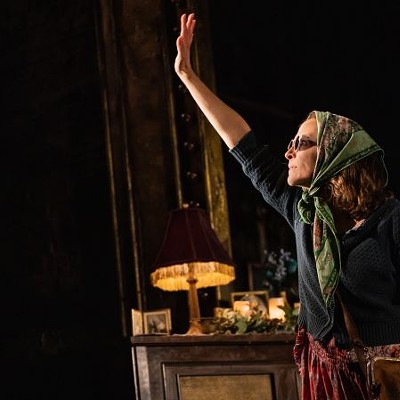If Oklahoma!, the first-ever collaboration between Theatre Under the Stars and Houston Ballet, is a tantalizing harbinger of things to come, bring it on!
Once you experience the glories of this re-animated Broadway classic, can you imagine the double-whammy of these two Houston powerhouses if they ever joined forces on Fiddler on the Roof, Hello Dolly, South Pacific, A Little Night Music, My Fair Lady?
Naturally, if you start off with a show that has great bones you're halfway there, and Oklahoma (1943) gives great face. It's so clean, pure, and free of filler.
The show is epic in theme (the building of a state; the clash between farmer and cowhand), yet personal and intimate (the love story of Curly and Laurey; the sexy on/off relationship between Ado Annie and Will). At the most basic level, the plot's homey and colloquial – who's the lucky guy to take Laurey to a box social? – but it's also the saga of young America coming together in common cause, building a community, forging a nation. There's a lot going on beneath the everyday surface of barn raising, sweet potato pies, and corn fields. That's why the musical resonated so deeply with audiences during the first months of our entrance into WW II. Oklahoma tells our story. (“The farmer and the cowhand should be friends...territory folks should stick together.”) Immediately at its premiere, the show was a smash. It remains one of the finest, most beloved, works in musical theater. No matter how you rank American musicals, Oklahoma is always in the top ten, if not the top five.
When composer Richard Rodgers, known for his urbane songs with lyricist Lorentz Hart (A Connecticut Yankee, Love Me Tonight, On Your Toes, I Married an Angel, Pal Joey), joined forces with Oscar Hammerstein II, preeminent lyricist /book writer of operettas (Show Boat, Rose-Marie, The Desert Song, New Moon), the duo created the new American musical. Neither of them knew it at the time, but their prickly collaboration completely altered the face of the American musical, bringing to it internal cohesion, sweeping romanticism, psychological realism, energy, and joy. Overnight, the superficial musical morphed into the “musical play.” Their progeny (Frank Loesser, Lerner and Lowe, Harnick and Bock, Stephen Sondheim) never looked back.
Directed by Kevin Moriarty, the TUTS production owes its physical look and subtext from Trevor Nunn's 1998 National Theatre production, which starred an incandescently jubilant Hugh Jackman as Curly, but its unique exuberance is due to the rich cast and the ultra-high-spirited choreography created by Houston Ballet's artistic director Stanton Welch and danced by HB's phenomenal dancers. (All Broadway gypsies take notice. This is unparalleled ensemble dancing/acting.)
Welch contrasts classical ballet steps – jetés (leaps), fouettés (whiplash turns), and melting attitudes (extended leg with bent knee) – with cowboys' bow legs, bouncy Texas two-step, and dreamy waltz. This is the danciest Oklahoma you'll ever see. The entire show floats on movement, even when it's not dancing.
Oh, but when it does...
Which number is Oklahoma's signature? The opening, “Oh, What a Beautiful Mornin',” with “dream Curly” (HB principal Ian Cassidy) reveling in the exquisite warmth of a summer morning with extended leg? The “Kansas City” number (“Everything's Up to Date in Kansas City”) where the “seven stories high” skyscraper is depicted by a successive line of dancers rising higher and higher, like a block of dominoes? Or maybe “Many a New Day,” where Laurey's girlfriends mock their macho beaus with guns-drawn attitude and faux-masculine swagger?
Certainly it must be the “Dream Ballet” where Laurey's id (HB principal Melody Mennite) makes itself visible. Ending Act I, this extended dance sequence is Oklahoma's most famous set piece, originally choreographed by modern dance master Agnes de Mille. Welch imbues this number with a psychological undertow made physical. Virginal Laurey is torn between true-love Curly and bad-boy Jud (HB soloist Christopher Coomer). As Jud paws and forces himself on her, the background dancers, lifted high, fall limp into their partners' arms, who then carry them offstage. Laurey shoots Jud, but the bullets have no effect. He keeps coming, unstoppable, inevitable.
Throughout, you don't know who are the dancers and who are the actors. It's this sly blend that makes this TUTS production so memorable. Act II opens with the exuberant “The Farmer and the Cowhand,” another set piece that showcases the entire company. Under Welch's theatrical magic, the number keeps building – more spins from Alyssa Springer, more aerodynamic double tours from Oliver Halkowich, who blurs the fringe on his chaps – until the entire ensemble is jubilantly two-steppin'. This company could raise a barn.
As wonderful as the dancers are, the actors fly high, too. Olivia Hernandez, as Laurey, has a crystal clear Broadway belt. She's a beautiful foil to Sam Simahk's boyish, blustery Curly, whose tenor is romance in sound. They play off each other naturally, and their anti-romantic duet “People Will Say We're in Love” is a master class of rom-com timing. Tony Award-winner Priscilla Lopez is appropriately flinty and sympathetic as Aunt Eller (the first Rodgers and Hammerstein earth mother role). Madeline Hamlet, as horny Ado Annie, has Kewpie-doll charm for days; while Christopher Campbel, as Annie's long-suffering paramour Will Parker, suffers gallantly and comically.
Hassan Nazari-Robati, as oily peddler Ali Hakim, does journeyman's duty in a role that should have been rewritten, or dropped, during the show's New Haven tryouts; but Eric Ulloa, as dyspeptic Jud Frey, possesses a creepy, misunderstood charm. Don't go into that smokehouse.
Anthony Ward did the touring production set featuring a water tower, windmill, and split-rail fence. Karen Perry's costumes are a riot of dusty gingham and calico, and Jason Lyons' lighting, when not randomly turned off and on as on opening night, is handsome and colorful as a cowpoke.
Except for an anemic overture, Maestro Kimberly Grigsby led a spirited orchestra with the original orchestration by Robert Russell Bennett from 1943. There are 24 musicians in the pit, even though the tinny amplification doesn't help anyone. And who can whine when a cast of 60+ rushes toward the footlights to belt out “Oklahoma”?
Rodgers and Hammerstein's Oklahoma is a theatrical lodestar, one of the pinnacles of Broadway. TUTS' production just might dance into history...via Houston Ballet.
Oklahoma! Continues September 11-23 at 7:30 p.m Tuesdays through Thursdays and Sundays; 8 p.m. Fridays and Saturdays; and 2 p.m. Saturdays and Sundays at the The Hobby Center, 800 Bagby. For information, call 713-558-8887 or visit tuts.com. $30 - $104.50.
Support Us
Houston's independent source of
local news and culture
account
- Welcome,
Insider - Login
- My Account
- My Newsletters
- Contribute
- Contact Us
- Sign out
TUTS and Houston Ballet Produce Oh What a Beautiful Evening in Oklahoma!
D. L. Groover September 14, 2018 9:39AM

Chicks and ducks and geese better scurry. Olivia Hernandez as Laurey and Sam Simahk as Curley in Oklahoma!
Photo by Melissa Taylor
[
{
"name": "Related Stories / Support Us Combo",
"component": "11591218",
"insertPoint": "4",
"requiredCountToDisplay": "4"
},{
"name": "Air - Billboard - Inline Content",
"component": "11591214",
"insertPoint": "2/3",
"requiredCountToDisplay": "7"
},{
"name": "R1 - Beta - Mobile Only",
"component": "12287027",
"insertPoint": "8",
"requiredCountToDisplay": "8"
},{
"name": "Air - MediumRectangle - Inline Content - Mobile Display Size 2",
"component": "11591215",
"insertPoint": "12",
"requiredCountToDisplay": "12"
},{
"name": "Air - MediumRectangle - Inline Content - Mobile Display Size 2",
"component": "11591215",
"insertPoint": "4th",
"startingPoint": "16",
"requiredCountToDisplay": "12"
}
,{
"name": "RevContent - In Article",
"component": "12527128",
"insertPoint": "3/5",
"requiredCountToDisplay": "5"
}
]
KEEP THE HOUSTON PRESS FREE...
Since we started the Houston Press, it has been defined as the free, independent voice of Houston, and we'd like to keep it that way. With local media under siege, it's more important than ever for us to rally support behind funding our local journalism. You can help by participating in our "I Support" program, allowing us to keep offering readers access to our incisive coverage of local news, food and culture with no paywalls.
D.L. Groover has contributed to countless reputable publications including the Houston Press since 2003. His theater criticism has earned him a national award from the Association of Alternative Newsmedia (AAN) as well as three statewide Lone Star Press Awards for the same. He's co-author of the irreverent appreciation, Skeletons from the Opera Closet (St. Martin's Press), now in its fourth printing.
Contact:
D. L. Groover
Trending Arts & Culture
- Reviews For The Easily Distracted:
Abigail - Houston Bookstore Crawl Celebrates Small Businesses and Literary Diversity
- The 10 Best And Most Controversial Hustler Magazine Covers Ever (NSFW)
-
Sponsored Content From: [%sponsoredBy%]
[%title%]

Don't Miss Out
SIGN UP for the latest
arts & culture
news, free stuff and more!
Become a member to support the independent voice of Houston
and help keep the future of the Houston Press FREE
Use of this website constitutes acceptance of our
terms of use,
our cookies policy, and our
privacy policy
The Houston Press may earn a portion of sales from products & services purchased through links on our site from our
affiliate partners.
©2024
Houston Press, LP. All rights reserved.






